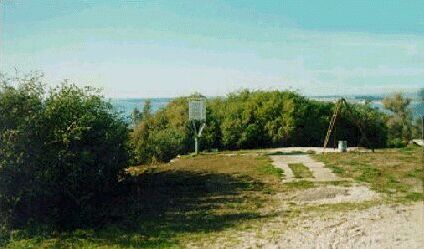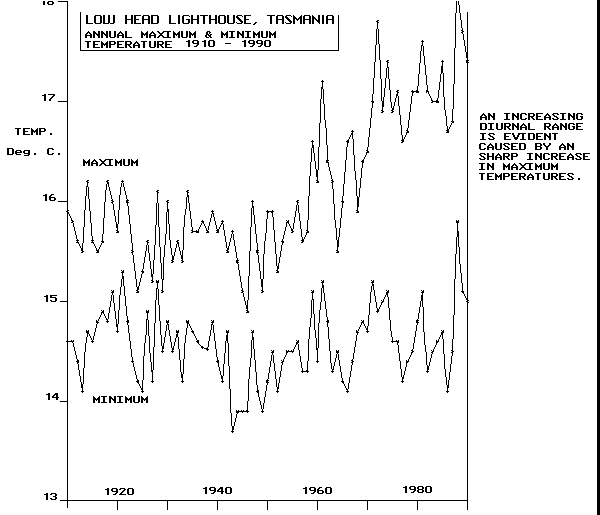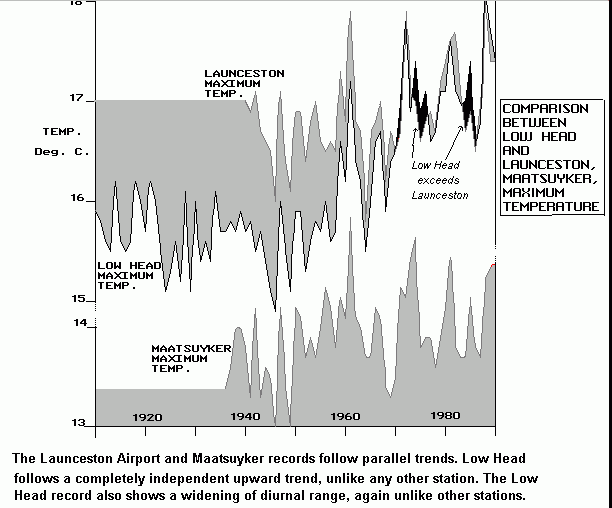
HOT
AIR AT LOW HEAD
by
John L. Daly
Low Head is a lighthouse on the northern coast of Tasmania, facing Bass Strait, at the mouth of the Tamar River. It has been used for many decades as a recording site for temperature and other meteorological measurements.
This afforded me the opportunity to test how well individual sites are assessed for their accuracy, given that trends showing up on thousands of such sites worldwide provide the raw material for claims by the Climate Research Unit (CRU) of the University of East Anglia, Norwich, UK, that the Earth is warming up due to Greenhouse.
I began by examining the temperature data held by the Australian Bureau of Meteorology.
Low Head showed a strong warming since 1960, but a closer examination of the data revealed this was mainly caused by a large daytime warming of about +1 deg since the early 1960's, with only a slight night-time warming (see Fig.2). The day-night contrast, or `diurnal range' has been widening, not narrowing as is usual with most other temperature records. This factor alone made Low Head grossly anomalous compared with stations elsewhere in the region and the rest of the world. Such anomalies are usually caused by poor siting of the instruments, allowing small environmental changes locally to skew the data over a period of time.
Comparison of Low Head's maximums with those of Launceston Airport (only 35 miles inland from Low Head) and Maatsuyker Island Lighthouse (off the south coast of Tasmania, a definitely clean site) reveals that while these other two station's variations were largely parallel to Low Head up to 1963, Low Head's daytime trend subsequently rocketed up, while Launceston Airport and Maatsuyker remained flat, and parallel with each other.
A personal inspection of Low Head soon revealed the answer. Site photographs from decades ago showed low-lying bushes only a few feet from the weather box, but well below the level of the box itself, leaving it fully exposed to the cool prevailing northwest wind. Today, those same bushes have grown up to box height and are now screening it from the prevailing wind coming directly off the sea. The site has become a little sun trap, with a resulting rise in daytime temperatures.

Fig.1 -
Low Head station as it looks today, view looking east.
Note the nearby bushes screening the box from the easterly and northwest
wind directions
(Photo. Bureau of Meteorology)

Fig.2. Maximum and Minimum Temperatures at Low Head Lighthouse
So, we have an isolated lighthouse station with some bushes causing a daytime anomaly to it's long-term data, resulting in the illusion of a strong warming trend. With many stations, the reverse happens, where a local anomaly causes a cooling trend. However, in this politically correct warming world, stations which show a healthy warming are curiously siezed upon by scientists to `prove' global warming, while stations with inconvenient cooling trends go largely ignored.
Such was the fate of Low Head.
It attracted attention from three research groups, each of them impressed by the warming trend showing up there, perhaps even deluding themselves that the warming was real and not merely an illusion. A scientist looking for warming might well be reluctant to ask too many questions about the soundness of some data just in case they get an answer inconsistent with their prejudices. With Low Head, such scientists had indeed found the warming they were looking for, such was it's strong warming trend.
One scientific group to mine the treasures of Low Head was a dendrochronological (tree ring studies) team led by a US scientists, Dr Ed Cook, who took samples of huon pine tree rings in western Tasmania, and correlated their recent growth with the temperature history of stations at Hobart, Launceston, and - surprise, surprise, - Low Head. (see The Trees Talk to Dr Ed Cook)
Thanks to the effect of Low Head skewing the combined data of the three stations, Ed Cook et al proudly announced they had found evidence of the impact of Global Warming, in a paper published in `Science'. ("Climatic Change in Tasmania Inferred from a 1089-year Tree-Ring Chronology of Huon Pine", Cook et al. 1991, Science, v.253, p.1266-1268)
In effect, Cook et al did a very professional job of statistically correlating the growth of distant huon pine trees, not with `Tasmanian temperatures' as they imagined, but with the slow growth of some humble bushes!
But it gets worse.
A second scientific body, The Australian National Climate Centre (Dr Neil Plummer, personal communication 28-Jan-93) confirmed that Low Head Lighthouse was now a `Climate Reference' station. In other words, it's temperature was taken as the temperature to be assumed valid for a wide area covering Bass Strait and much of Tasmania itself. It's effect would be to skew the Australian regional temperature estimates, and therefore the Southern Hemisphere as a whole. Plummer confirmed that, to date, no corrections had been applied to it's historical record. (See Plummer's response to this issue)
But there's yet more.
Low Head was also one of 49 stations selected by Jones et al of the Climate Research Unit (CRU), (who were satirically dubbed "The Gnomes Of Norwich" by an Australian climate researcher) for their 1990 study testing for urban heating effects (Jones et al. "Assessment of Urbanization Effects in Time Series of Surface Air Temperature Over Land", Nature, vol.347 13-9-1990, p.169-172)).
The point of this paper was to present a set of 49 mostly `rural' stations in eastern Australia (they were not really rural as their average population was 5,000), to validate the warming results showing up from their larger, more urban- based, measuring network. As to how the magic 49 were selected (including Low Head), while other stations were excluded is something of a mystery. The criteria, we are assured, was scientific, but one suspects that a nice healthy warming like that of Low Head went a long way towards a station meeting the criteria. And why not? Low Head is a real gift if you are looking for evidence, any evidence, of global warming.
From Fig.3 below, we can see the comparative movements between Low Head itself (middle graph) and nearby Launceston Airport (upper graph) and Maatsuyker Island Lighthouse (lower graph) off the south coast of Tasmania.
Although it is clear (and to be expected) that Launceston is warmer than Maatsuyker, it is also clear that they warm and cool in lock-step on a year to year basis, and both show little overall warming or cooling since 1960.

Fig.3 The Low Head Anomaly since 1965
But look at Low Head! It is the middle graph, starting about half-way between Launceston and Maatsuyker in 1960, but then surging ahead over a 30-year period, to the point where it became even warmer than Launceston.
It is difficult to comprehend how Low Head's daytime anomaly and it's widening diurnal range, could have escaped the attention of the various groups compiling regional and hemispheric temperature series. Even the Cook team included one member (R. Francey) from Australia's CSIRO Division of Atmospheric Research who should have noticed this anomaly. Low Head's current status as a `climate reference' station merely demonstrates the degree to which science can turn a blind eye to questionable data - if that data helps to prop up a fashionable theory.
The Low Head anomaly is so obvious from the data itself, why did these groups select it? The only de facto criterion seems to be whether the station in question is warming or not. If it is warming strongly, it is readily included in a data set, and conveniently left uncorrected. If it shows a neutral trend, or even a cooling (as many do), any minor defects, blips or gaps in the data becomes a convenient pretext to exclude the station from the data set entirely. In that way, an apparent warming bias is easily built into the reference station network. Some scientists may not even do this consciously, but simply act upon a psychological expectation of warming created by years of hype, ie. they may be victims of autosuggestion.
As an example of "careful use of basic station data" (Philip Jones' (CRU) own judgement of his own methods, 1990), it does not inspire confidence in the integrity of other historical records selectively chosen by these groups for regional and hemispheric temperature studies.
After all, one rotten apple in the barrel makes all the rest suspect too.
![]()
Reply by Neil Plummer of Australia's National Climate Centre to the issues raised above about Low Head Lighthouse and other `Climate Reference Stations' in Australia.
Return to "Still Waiting For Greenhouse"